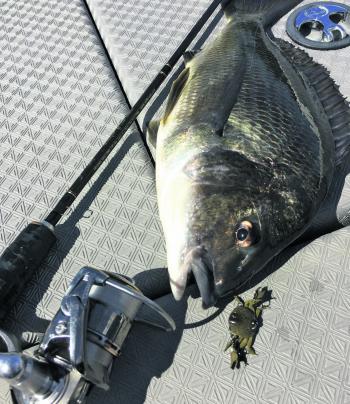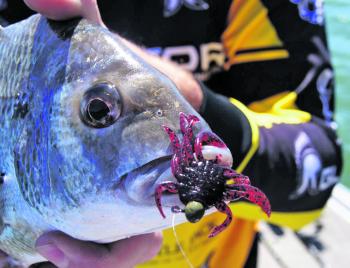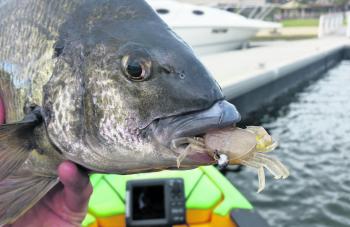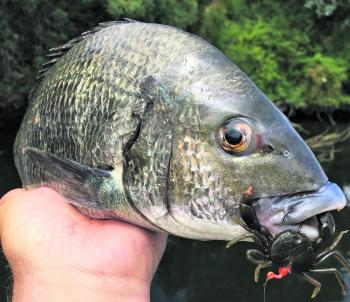Roll back the clock five years and you wouldn’t find many anglers with a crab-style lure in the tackle box. Sure, some companies tried to get a crab imitation right, but a lack of appetite combined with a lack of knowledge meant that these baits seemed destined for the specials bin – usually sooner rather than later.
And it didn’t make sense, because crustaceans like crabs and prawns form a major part of the diet of both inshore and offshore species. Prawn imitations have been around in various forms for decades – from the DOA Prawn to the PrawnStar, they’ve carved quite a niche from flathead through to barramundi and other top level estuary and inshore predators.
The recent ‘rise of the crab’ was clearly well overdue.
For this rise, we can basically blame one guy: Steve Steer from Cranka Lures. Steve is an inventive, obsessive and meticulous lure designer who has more in common with Dr Emmet Brown from Back to The Future than the lab coat wearing designers we used to see in the old Berkley ads. He was the one who would pick up a handful of crab legs out of a livewell at the end of a bream tournament and think that there was an opportunity to make a better bait.
So he did it.
The Cranka Crab was released at an AFTA (Australian Fishing Trade Association) Show on the Gold Coast in 2012 and, after some initial supply issues, became an instant favourite amongst bream tournament anglers.
There’s always more than one way to skin a cat, and in subsequent years, competitive manufacturers have explored alternative methods to present a crab profile lure to fish. In this article we have collected all of the commonly available crab lures on the Australian market today.
What we quickly noticed was that making a crab imitation isn’t a simple process. Crabs, with their hard exoskeleton, are a complicated organism and in replicating their looks and behaviour, manufacturers have had to use nearly the full spectrum of materials, from hard plastic and metals through to softer plastics.
Single, double, treble and double treble hooks have all been used to create a system that effectively catches the predators that try to eat the crabs. Understanding just how each of the lures behaves in the water better educates the angler about which of the crabs will do the best for them.
After all, it’s no good throwing a bait with tiny trebles at a fish weighing over 20lb on heavy line. The corollary is that you shouldn’t target finesse species with the big guns.
Luckily, there now exists a crab bait for any application you can think of – from drifting around the washes for oceanic crab eaters to plummeting a bigger crab to the bottom on a shallow reef, right through to finesse applications for bream and other estuary scavengers.
Also, there’s a crab at a price point to cast into the nastiest of structure. If you don’t want to lob a $20 bait into the nastiest snag on the river, then you can choose a soft plastic/jighead option that’ll come in at a fifth of that price.
Admittedly, I’ve used crab imitations for bream a lot over the past few years. Bream are finicky and especially in clear water, will often examine a bait for a long time before eating it. And although I’ve hooked a giant herring on a crab skipping in along the surface on a fast retrieve after a cast, the one lesson I’ve learned from crab fishing is to fish them SLOW.
S-L-O-W.
Crabs don’t move that fast at the best of times and in their natural environment, they usually dawdle along the bottom. Even under attack, crabs tend to assume a ‘defensive’ position, rearing their claws upwards and slowly backing or sidestepping away from danger.
Their danger response is very different from a prawn (that will flick and skip away across the top) or a baitfish (that will just run for its life). A crab will stand its ground and that’s the reason a slow retrieve works so well.
Ever tried to pick up a mud crab you encountered on a river bank? You know what I mean. Approach them and they’re all snapping claws.
Some predators will intercept a crab on its way to the bottom (like a snapper or a mulloway), but the majority of bites will come as the crab drops near the bottom or while it’s near structure.
Also, you need to understand the hook configuration when it comes to how you set the hook. There’s a bit of a difference between crabs with hooks in the claws and crabs with a larger hook in the body.
I find that with a claw-hooked crab, you can basically wind to set the hook at the first sign of a bite. Fish usually attack the claws first and end up hooking themselves on the trebles or the stinger hooks. The fish doesn’t need to swallow the crab.
Crabs with a body-hook are another matter. The predator usually won’t get hooked while nipping at the claws and you need to let the fish swallow the lure a little before setting the hook.
On the water, this means that you need to let the fish eat the bait a little before setting the hook – and when you do set the hook you need to maybe swing a little harder than with the finesse versions.
It’s horses for courses. Fish may be harder to hook on the bigger single hooks and jigheads, but in tough country and pulling hard with heavy lines, a big hook locked squarely in the jaw may well be a more secure hookup than some trebles in the skin of the lips.
In summary: think of fishing your crabs more like the way you’d use a live crab for bait than you would fishing a traditional lure. Save the burn-n-kill or jerky retrieves for your baitfish profiles.
Let’s now take a look – manufacturer by manufacturer – at what’s available on the Australian market today.
Without doubt the biggest selling crab imitation in Australia, Cranka Crabs look realistic and have caught dozens of species of fish all over the country.
Perhaps the best example of their effectiveness was at the BREAM Grand Final in 2015 on the Clarence River in NSW, where nearly the full field of 100 anglers were fishing this bait. NSW angler Liam Carruthers ultimately walked away with the win on a heavy, olive version of the small Cranka Crab.
With the smaller two crabs in the range, Steve Steer says that it’s the unique floating hooks that make all of the difference, and it’s a feature that he’s spent the time and money to protect through the lodgement of patents and registered designs.
“The sinking body and floating claws are the key to the success of the smaller crabs. We did years of R&D to see how crabs behaved in the wild to design a lure that would be successful and our patent pending, registered designs have proven to be very successful in the field,” he said.
Indeed, the success of these baits caused major supply problems for Cranka over the first few years after release.
“Our supply chain is now secure and we have good stocks of all of the crab models available – with the new large, single hook model stocks arriving in store very soon,” Steer said.
Tournament bream fishers in particular also like the fact that the bream have a habit of hooking up with a treble hook in each side of the lips. This means that big bream spend most of their time shaking their head and trying to dislodge the bait rather than sprinting for the nearest cover. That’s a big plus when you hook a big bream in heavy cover.
Recently, Aussie Richard Somerton took some of the 65mm crabs to the Hobie Fishing Worlds in Lousiana, USA after winning the World Titles in Australia on the 50mm crabs a couple of years before. He finished second there on a species he hadn’t fished for before using the Aussie designed bait that the fish hadn’t seen before.
It just goes to show that fish eat crabs worldwide!
Never far from the cutting edge of the latest tackle, River2Sea have created crab imitations that suit both ends of the market – the large Smash Crab for inshore and offshore presentations and the small Crusty Crab for bream and bass size fishing.
Both use the robust 10X material, which is near bulletproof and floats. Internal weights get the crab down to where it needs to be and the model of a single, upward facing hook in the Smash Crab will be replicated in the smaller crabs in the future.
“Current stocks of the Crusty Crab have the double hooks but these will be transitioning to single hooks in future production runs,” said Grainger Mayfield, R2S Chief.
Interestingly, the Smash Crab and the single hook Cranka are the only ones currently available that are suitable for serious rock fishing and offshore use.
“Our best markets at the moment for the Smash Crab are Queensland and Western Australia. Guys are catching plenty of big reef fish on these lures and that’s where they’ve found their niche. Red emperor, snapper, tuskfish and a whole pile of reef species that eat crabs are loving the Smash Crab,” Grainger explained. “There’s even been some barra reported on them.
“The Crusty Crab is a totally different market – we’re finding that it’s 50% bass and 50% bream – that means that the east coast through to Tassie is where we sell most of these,” Mayfield continued. “The changes to the Crusty crab are to fix a single hook into the lead and present it in the best position for a hookup. That means that it will be facing forward and not sideways.”
When storing any of the crabs made from the 10X material, it’s pretty important to not mix them with regular plastics. If you do, you’ll end up with a runny mess of plastic that will render your hard earned baits useless.
The best way is to keep them in the box they came in, or – at the very least – keep them in a separate compartment in your tackle box.
Nobody likes expensive surprises.
Peter Nord of Lakes Entrance is the man behind the Hurricane brand. Living in the heart of big black bream country, it was inevitable that he’d eventually have a crab imitation in his extensive estuary luring range.
Hurricane’s Spider Crab fits in between soft plastic and hardbodied crabs. They are essentially a 10X soft plastic but are marketed with dedicated jigheads and rigging systems that allow you to mix and match weight and hooks, depending on the quarry you are chasing.
If you’re fishing for a fish that is inclined to swallow the crab whole, you can choose the standard jighead rigging option. Or if you are fishing for quarry that will nip at the crab then the stinger hook kit may be a better option for you.
Hurricane’s YouTube channel demonstrates rigging techniques – both of which require the use of some Loctite Control Gel glue to ensure a lasting connection.
“That Loctite Gel is the best we have found for attaching 10X plastic to our jigheads. You can control it better than liquid super glue products and its applicator is very angler-friendly,” Peter explained. “The crabs are representative of the crabs that bream eat in my local estuaries, so we find that bream have no problems smackin’ em – although anything that eats a crab in your local river will have a go at the Spider Crab.”
The Spider Crabs also have a scent added to the plastics to help stimulate bites. You can notice it as soon as you open the packet.
The best way to store the Hurricane Spider Crab system is in its original packaging – the plastic trays keep the baits nice and neat and away from anything that will react negatively with the material.
The brand of soft plastics that Aussies have embraced so heartily has a couple of models which fit the crab profile. Tackle Tactics’ Justin Willmer knows the A-to-Z on ZMan and explains.
Made from 10X plastic, both models float without the addition of a jighead and should be stored separately, if not in their original packaging.
“The CrusteaZ have developed a strong following among anglers fishing structure, including moored boats, pontoons and natural structure, when chasing species such as bream, as well as when finesse flats fishing for a range of species,” Justin said.
The Scented CrabZ are the more realistic of the two ZMan offerings.
“This versatile size crab profile has proven effective fished weedless in the mangroves for barramundi and jacks,” Justin continued. “It’s also found a following lightly weighted on the flats for crab-loving species such as bluebone and trevally, or more heavily weighted when prospecting reef edges and deeper structure for cobia and snapper.”
The Berkley Gulp Crabby is a bait that has 100% been embraced by tournament anglers. Selling literally thousands of packets every year, Pure Fishing’s Chris Gates explains why they are so successful in their niche.
“The Gulp Crabby has been a mainstay in the bream fishing arena for some years with tens of thousands of packs being sold,” Chris said. “More recently we have witnessed bass anglers take them up, recognising their similarity not only to a freshwater crustacean but also to a hapless spider or bug that may have dropped from an overhanging tree. Worked slowly across the bottom, they are proving just as deadly in the freshwater as the salt.”
Being a bio-bait and not a plastic, all Gulp baits should be stored in their original packets and make sure that they are well sealed. The next ‘Gulp juiced’ tackle box that’s not allowed back into the house – ever – won’t be the first.
With the design for the Enticer Finesse Crab done in Australia, Strike Pro used its advanced plastics manufacturing facility in Asia to get the samples just right. Rick Massie explains.
“We got samples in lots of different densities and we found that the stiffest, neutrally buoyant plastic gave the best action,” Rick said.
“To me, the best thing about the Strike Pro Crab is the fact that by simply changing the jighead, you can fish all depths in an estuary effectively – from the surface [on a worm hook] to the deepest channels [with a heavy jighead],” he continued.
The heartland of the Finesse Crabs has been from the south coast of NSW through Victoria and into Tasmania.
“Although there are Enticer jigheads to suit the crab which are made on a #4 hook (1.16oz and 1/20oz are the most popular), you can fish the Finesse Crab on a cobra style jighead to stand it in a defensive position, a HWS style jighead to slow the fall or a Gamakatsu 211 jighead as an all round option – the combinations are endless,” Rick concluded.
For me, it’s about creating a bait that costs you a couple of bucks when you cast it into the nastiest cover imaginable. You feel better when three or four bucks disappears in a swirl rather than $20 more than that.
All Strike Pro Crabs are impregnated with a crab scent in the manufacturing process.
A last minute inclusion into the review, I found a couple of packs of these Japanese plastics – imported by Gladiator Tackle – as I was grabbing samples for photography from the garage.
Pre-Cranka, these were my go-to baits for crawling down rock walls for crab-eating bream – hence the rigging on a snag-proof jighead.
A quick call to Steve Blackmore from Gladiator revealed that these baits are still available and shipping around the country to crab enthusiasts.
Requiring the slightest water movement to get the legs fluttering in the water, they’re ideal for light line, finesse situations. Fishing them on straight through 2lb or 3lb fluorocarbon was a favourite in low current areas.
The newest kid on the block is Japanese manufacturer Valley Hill. Imported by Dogtooth Distribution in Australia, the Gulf Bug is an interesting little bait that just scraped into the ‘crab imitation’ category.
Made of a lead head, a free swinging assist hook and a crustacean profile cut from rubber material, it’s an abstract version of a bottom dwelling crab that’s remarkably fishable.
My prediction is that – especially in deeper water – these baits will prove very effective. It doesn’t take much current to get the appendages moving and the hook is in the right position to suck easily into a predator’s mouth.
In the test tank they look great and climb over structure with ease.
Modern day blades, which are ridiculously popular, came from the same country and from the same lateral thinking fishing minds. Watch this space to see how techniques develop with this bait.
Throughout this article, you’ll have noticed me harping on about correct storage for crabs. If you go out and spend $100 on a selection of crabs and proceed to load them all into one tray of your tackle box, you can definitely run into problems.
You need to store Crankas flat, 10X plastics separately and Gulp In a watertight container. If you don’t you’ll be faced with a sticky and/or dried out, bent mess when you go to fish them, and none of us want that frustration in our lives.
Fishing is supposed to be fun. Crabs can help. Store them right and fish them slow.
Reads: 6656
Fish Candy’s Smash Crab is finding a nice little niche amongst offshore anglers – red emperor, snapper and many other reefies love a feed of crab. Pic courtesy River 2 Sea.

We’d like a dollar for every big, smart ol’ bream that’s been fooled by a Cranka Crab over the last few years. This one came from Forster, NSW.

In heavily pressured fisheries, there’s nothing more convincing than a crab imitation fished on 2lb fluorocarbon. Can get a little expensive, though, if you end up losing a battle or two…

Bait Breath Rock’n Crabs aren’t the easiest baits to get a hold of, but were the preferred crab imitation for plenty of breamers before the Cranka tidal wave.

Strike Pro’s Enticer Finesse Crab is very versatile – you can fish it anywhere between the top and bottom depending on jighead selection.

Hurricane’s Spider Crab is a soft plastic bait with a variety of custom-designed heads of different weights that allow for different presentations.




